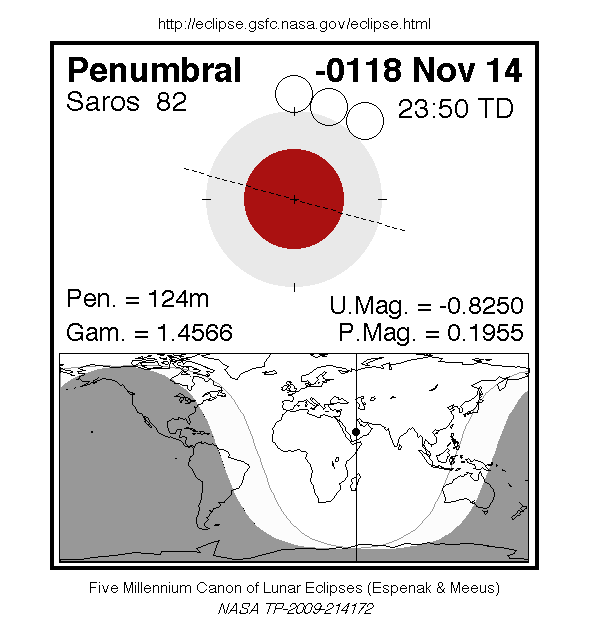A penumbral eclipse of the Moon occurred on 14 November, 0119 BC UT Old Style, with maximum eclipse at 20:34 UT. In this extremely marginal eclipse, the Moon barely clipped the edge of the Earth's penumbral shadow. This caused a microscopic darkening of just 20% of the Moon's disc for 2 hours and 4 minutes, which was essentially impossible to see.
The penumbral eclipse lasted for 2 hours and 4 minutes.
Maximum eclipse was at 20:34:02 UT.
Overview Map
This map sourced from NASA Goddard Space flight Center: GSFC Eclipse Web SiteGSFC Eclipse Web Site
The primary source of all the information on eclipses presented here at Hermit Eclipse. (NASA Goddard Space flight Center)
shows the visibility of the eclipse. (Click on it for the
full-sized version.)
Eclipse Season and Saros Series
This eclipse season contains 3 eclipses:
This was the 6th eclipse in lunar Saros series 82.The surrounding eclipses in this Saros series are:
Eclipse Parameters
| UT Date/time (max) | 20:34:02 on 14 Nov UT |
TDT Date/time (max) | 23:50:14 on 14 Nov TDT |
| Saros Series | 82 |
Number in Series | 6 |
| Penumbral Magnitiude | 0.1955 |
Central Magnitiude | -0.825 |
| Gamma | 1.4566 |
Path Width (km) | |
| Delta T | 3h16m |
Error | ± 9m48s (95%) |
| Penumbral Duration | 2h04m |
Partial Duration | |
| Total Duration | |
| |
| Partial Rating | |
Total Rating | |
Note that while all dates and times on this site (except
where noted) are in UT, which is within a second of civil time,
the dates and times shown in NASA's eclipse listingsGSFC Eclipse Web Site
The primary source of all the information on eclipses presented here at Hermit Eclipse. (NASA Goddard Space flight Center)
are in the TDT timescale.
Data last updated: 2015-06-21 22:11:42 UTC.

